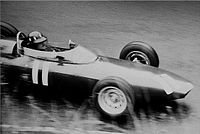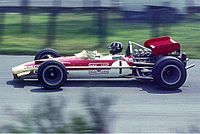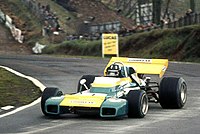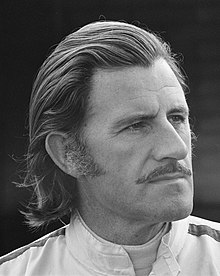|
Graham Hill
Norman Graham Hill (15 February 1929 – 29 November 1975) was a British racing driver, rower and motorsport executive, who competed in Formula One from 1958 to 1975. Nicknamed "Mr. Monaco",[b] Hill won two Formula One World Drivers' Championship titles and—at the time of his retirement—held the record for most podium finishes (36); he won 14 Grands Prix across 18 seasons. In American open-wheel racing, Hill won the Indianapolis 500 in 1966 with Mecom. Upon winning the 24 Hours of Le Mans in 1972 with Matra, Hill became the first—and to this date, only—driver to complete the Triple Crown of Motorsport.[c] Born and raised in London, Hill studied engineering before completing national service in the Royal Navy. He was a member of London Rowing Club from 1952 to 1954, contesting twenty finals and stroking the London crew in the Grand Challenge Cup. He made his racing debut in Formula Three aged 25. He initially joined Lotus in Formula One as a mechanic, before earning a driving debut with the team at the 1958 Monaco Grand Prix and securing a full-time contract. After non-classified championship finishes in 1958 and 1959 with Lotus, Hill moved to BRM in 1960, scoring his maiden podium at the Dutch Grand Prix. BRM fielded the competitive P57 in 1962, with Hill taking his maiden victory at the season-opening Dutch Grand Prix and winning three further Grands Prix as he secured his maiden title, beating career rival Jim Clark and Bruce McLaren. He finished runner-up to Clark the following season, before losing the 1964 title by one point to John Surtees.[d] Hill took multiple wins in 1965 as he finished runner-up to Clark once more in the standings. After a winless 1966 campaign, Hill returned to Lotus to partner Clark. Helping develop the Lotus 49 for the new Cosworth DFV engines, Hill struggled with reliability throughout 1967, with podiums in Monaco and the United States. Clark was killed after their 1–2 finish at the season opener in 1968, leaving Hill in a close title battle with Jackie Stewart, which Hill won at the final race of the season. In 1969, Hill became a five-time winner of the Monaco Grand Prix, a record he held for 24 years. During the United States Grand Prix, Hill was seriously injured in a crash, breaking both of his legs and ending his season prematurely. After recovering from his injuries, he returned as a privateer in 1970 before competing with Brabham for two further seasons, where he won the non-championship BRDC International Trophy in 1971. Hill founded and competed for Embassy Hill from 1973 to 1975, retiring from motor racing after the Monaco Grand Prix to focus on team ownership and supporting his protégé Tony Brise. In addition to his two championships, Hill achieved 14 race wins, 13 pole positions, 10 fastest laps and 38 podiums in Formula One. Outside Formula One, Hill entered the 24 Hours of Le Mans 10 times between 1958 and 1972, winning the latter alongside Henri Pescarolo in the Matra-Simca MS670. He also entered the Indianapolis 500 three times from 1966 to 1968, winning the Borg-Warner Trophy at his first attempt. Throughout his early years, Hill also competed in the British Saloon Car Championship, topping his class in 1963, and entered six seasons of the Tasman Series, finishing runner-up to Stewart in 1966. In November 1975, Hill and five other Embassy Hill executives, including Brise, were killed when the Piper PA-23 Aztec aircraft Hill was piloting crashed in low-visibility conditions in north London whilst returning from a test session for the Hill GH2 at the Circuit Paul Ricard. Embassy Hill subsequently shut down ahead of the 1976 season. Hill's son Damon went on to win the World Drivers' Championship in 1996, becoming the first father-and-son World Drivers' Champions. Hill was inducted into the International Motorsports Hall of Fame in 1990. Early lifeHill was born in Hampstead, London, one of two sons of stockbroker Norman Herbert Devereux Hill, of Belsize Park, and his wife Constance Mary, née Philp.[2] He attended Hendon Technical College and joined Smiths Instruments as an apprentice engineer. He was conscripted into the Royal Navy and served as an Engine Room Artificer (ERA) on the light cruiser HMS Swiftsure, rising to the rank of petty officer. After leaving the navy he rejoined Smiths Instruments.[3] Racing career Hill did not pass his driving test until he was 24 years old, and he himself described his first car as "A wreck. A budding racing driver should own such a car, as it teaches delicacy, poise and anticipation, mostly the latter I think!"[4] He had been interested in motorcycles but in 1954 he saw an advertisement for the Universal Motor Racing Club at Brands Hatch offering laps for five shillings. He made his debut in a Cooper 500 Formula 3 car and was committed to racing thereafter. Hill joined Team Lotus as a mechanic soon after but quickly talked his way into the cockpit. The Lotus presence in Formula One allowed him to make his debut at the 1958 Monaco Grand Prix, retiring with a halfshaft failure.[5] In 1960, Hill joined BRM, he won also in that year on 8 May 1960 the Targa Florio in the class Sports 1600 together with a German driver Edgar Barth in a Porsche 718, and won the world championship with BRM in 1962. He was known for his race preparation, keeping records of the settings on his car and working long hours with his mechanics.[6] Hill was also part of the so-called 'British invasion' of drivers and cars in the Indianapolis 500 during the mid-1960s, triumphing there in 1966 in a Lola-Ford.[7] At the same time, Hill along with his F1 contemporaries competed in the British Saloon Car Championship, scoring several outright wins. He achieved a best finish of sixth overall in 1961 driving a Jaguar Mark 2.[8]  In 1967, back at Lotus, Hill helped to develop the Lotus 49 with the new Cosworth-V8 engine. It fell to Hill to perform the initial testing of the new car and its engine. After the first shakedown run, Hill quipped "Well, it's got some poke! Not a bad old tool."[9] After teammates Jim Clark and Mike Spence were killed in early 1968, Hill led the team, and won his second world championship in 1968. The Lotus had a reputation of being very fragile and dangerous at that time, especially with the new aerodynamic aids which caused similar crashes of Hill and Jochen Rindt at the 1969 Spanish Grand Prix. A crash at the 1969 United States Grand Prix at Watkins Glen broke both his legs and interrupted his career. Typically, when asked soon after the crash if he wanted to pass on a message to his wife, Hill replied "Just tell her that I won't be dancing for two weeks."[10] Upon recovery Hill continued to race in F1 for several more years, but never again with the same level of success. Colin Chapman, believing Hill was a spent force, placed him in Rob Walker's team for 1970, sweetening the deal with one of the brand-new Lotus 72 cars. Although Hill scored points in 1970 he started the season far from fully fit and the 72 was not fully developed until late in the season. Hill moved to Brabham for 1971–2; his last win in Formula One was in the non-Championship International Trophy at Silverstone in 1971 with the "lobster claw" Brabham. The team was in flux after the retirements of Sir Jack Brabham and then Ron Tauranac's sale to Bernie Ecclestone; Hill did not settle there.  Hill was known during the latter part of his career for his wit and became a popular personality – he was a regular guest on television and wrote a notably frank and witty autobiography, Life at the Limit,[11] when recovering from his 1969 accident. A second autobiography, which covered his career up until his retirement from racing simply called Graham was published posthumously in 1976.[12] A staunch campaigner for road safety, Hill presented a series for Thames Television entitled Advanced Driving with Graham Hill comprising six 30-minute programmes broadcast weekly in June and July 1974.[13] A book accompanying the series giving advice on safer and responsible driving was co-written by him.[14] Hill was also irreverently immortalized on a Monty Python episode ("It's the Arts (or: Intermission)" sketch called "Historical Impersonations"), in which a Gumby appears asking to "see John the Baptist's impersonation of Graham Hill." The head of St. John the Baptist appears (with a stuck-on moustache in Hill's style) on a silver platter, which runs around the floor making putt-putt noises of a race car engine.  Hill was involved with four films between 1966 and 1974, including appearances in Grand Prix and Caravan to Vaccarès, in which he appeared as a helicopter pilot.[15] During a Christmas Eve 1970 special of BBC's Tomorrow's World Hill played against Raymond Baxter on an early computer racing game, with data centre workers Anne Norie and Margaret Watson manning the terminals for the game.[16] Although Hill had concentrated on F1 he also maintained a presence in sports car racing throughout his career (including two runs in the Rover-BRM gas turbine car at Le Mans). As his F1 career drew to a close he became part of the Matra sports car team, taking a victory in the 1972 24 Hours of Le Mans with Henri Pescarolo. This victory completed the so-called Triple Crown of Motorsport which is alternatively defined as winning either:
Using either definition, Hill is still the only person ever to have accomplished this feat. Hill set up his own team in 1973: Embassy Hill with sponsorship from Imperial Tobacco. The team used chassis from Shadow and Lola before evolving the Lola into its own design in 1975. After failing to qualify for the 1975 Monaco Grand Prix, where he had won five times, Hill retired from driving to concentrate on running the team and supporting his protege Tony Brise. Along with Stirling Moss, Hill put his name to and supported the Grand Prix Midget Championship, which started in 1975, with the aim of bringing low cost motor sport to people who wanted to try a new career.[22] Hill's record of 176 Grand Prix starts remained in place for over a decade until being equalled by Jacques Laffite. FamilyHill married Bette in 1955; because Hill had spent all his money on his racing career, she paid for the wedding. They had two daughters, Brigitte and Samantha, and a son, Damon, who himself later became Formula One World Champion – the first son of a former world champion to emulate his father. The family lived in Mill Hill during the 1960s. The house now features an English Heritage blue plaque.[23] During the early 1970s, Hill moved to Lyndhurst House in Shenley in Hertfordshire. The house is now owned by musician Jeff Wayne.[24] Well known for throwing extravagant parties at his houses to which most of the Grand Prix paddock and other famous guests attended, Hill was universally popular.[25] Rowing Before taking up motor racing, Hill spent several years actively involved in rowing. Initially, he rowed at Southsea Rowing Club, while stationed in Portsmouth with the Royal Navy and at Auriol Rowing Club in Hammersmith. He met his future wife Bette at a Boxing Day party at Auriol and, while courting her, he also coached her clubmates at Stuart Ladies' Rowing Club on the River Lea. In 1952 he joined London Rowing Club, then as now one of the largest and most successful clubs in Great Britain. From 1952 to 1954, Hill rowed in twenty finals with London, usually as stroke of the crew, eight of which resulted in wins. He also stroked the London eight in the highly prestigious Grand Challenge Cup at Henley Royal Regatta, losing a semi-final to Union Sportif Metropolitaine des Transports, France by a length. Through his racing career he continued to support rowing and London. In 1968 when the club began a financial appeal to modernise its clubhouse, Hill launched proceedings by driving an old Morris Oxford, which had been obtained for £5, head-on into a boundary wall. Hill made three runs to reduce the wall to rubble, and the car was subsequently sold for £15.[citation needed] Hill felt that the experience gained in rowing helped him in his motor-racing. He wrote in his autobiography: "I really enjoyed my rowing. It really taught me a lot about myself, and I also think it is a great character-building sport...The self discipline required for rowing and the 'never say die' attitude obviously helped me through the difficult years that lay ahead." Hill adopted the colours and cap design of London Rowing Club for his racing helmet – dark blue with white oar-shaped tabs. His son Damon and grandson Josh later adopted the same colours with permission from the club.[26] DeathHill died on 29 November 1975 at the age of 46 when his Piper PA-23 Aztec twin-engine light aircraft crashed near Arkley in the London Borough of Barnet, while on a night approach to Elstree Airfield in thick fog. On board with him were five other members of the Embassy Hill team who all died: manager Ray Brimble, mechanics Tony Alcock and Terry Richards, driver Tony Brise, and designer Andy Smallman. The party was returning from a car-testing session at the Paul Ricard Circuit in southern France.[27][28][29] The subsequent investigation revealed that Hill's aircraft, originally registered in the US as N6645Y,[30] had been removed from the FAA register and at the time of the accident was "unregistered and stateless", despite still displaying its original markings. Furthermore, Hill's American FAA pilot certification had expired, as had his instrument rating. His UK IMC rating, which would have permitted him to fly in the weather conditions that prevailed at the time, was also out of date and invalid. Hill was effectively uninsured.[31] The investigation into the crash was ultimately inconclusive, but pilot error was deemed the most likely explanation.[29] Hill's funeral was held at St Albans Abbey, and he is buried at St Botolph's graveyard, Shenleybury. The church has since been deconsecrated so the tomb now sits in a private garden. LegacyAfter his death, Silverstone village, home to the track of the same name, named a road, Graham Hill, after him[32] and there is a "Graham Hill Road" on The Shires estate in nearby Towcester. Graham Hill Bend at Brands Hatch is also named in his honour. A blue plaque commemorates Hill at 32 Parkside, in Mill Hill, London NW7.[33] In Bourne, Lincolnshire, where Hill's former team BRM is based, a road called Graham Hill Way is named in his honour. Also a nursery school in Lusevera, Italy, was named in his honour.[citation needed] Bibliography
Career resultsCareer summaryComplete Formula One World Championship results(key) (Races in bold indicate pole position, races in italics indicate fastest lap) Complete Formula One non-championship results(key) (Races in bold indicate pole position) (Races in italics indicate fastest lap) Complete USAC Championship Car results
Indianapolis 500 results
Complete Tasman Series results
24 Hours of Le Mans results
Complete British Saloon Car Championship results(key) (Races in bold indicate pole position; races in italics indicate fastest lap.)
† Events with 2 races staged for the different classes.
Complete Canadian-American Challenge Cup results(key) (Races in bold indicate pole position) (Races in italics indicate fastest lap)
Honours and awardsHill's easy wit and charm helped him become a television personality, notably on the BBC show Call My Bluff with Patrick Campbell and Frank Muir. For a number of years in the early 1970s he appeared as one half of a double act, with Jackie Stewart, as an insert within the BBC Sports Personality of the Year show. In June 1975 he appeared alongside his son, Damon Hill, on the popular television programme Jim'll Fix It.[40] His appearance was later rebroadcast as part of the twentieth anniversary celebrations of the programme in January 1995, with Damon presenting a new segment at the end.[41] Hill was appointed Officer of the Order of the British Empire (OBE) in the 1968 Birthday Honours for services to motor racing.[42] In 1990, he was inducted into the International Motorsports Hall of Fame. A one-off BBC Four documentary called Graham Hill: Driven was first broadcast on 26 May 2008.[43] Notes
See alsoReferences
External linksWikimedia Commons has media related to Graham Hill. |
||||||||||||||||||||||||||||||||||||||||||||||||||||||||||||||||||||||||||||||||||||||||||||||||||||||||||||||||||||||||||||||||||||||||||||||||||||||||||||||||||||||||||||||||||||||||||||||||||||||||||||||||||||||||||||||||||||||||||||||||||||||||||||||||||||||||||||||||||||||||||||||||||||||||||||||||||||||||||||||||||||||||||||||||||||||||||||||||||||||||||||||||||||||||||||||||||||||||||||||||||||||||||||||||||||||||||||||||||||||||||||||||||||||||||||||||||||||||||||||||||||||||||||||||||||||||||||||||||||||||||||||||||||||||||||||||||||||||||||||||||||||||||||||||||||||||||||||||||||||||||||||||||||||||||||||||||||||||||||||||||||||||||||||||||||||||||||||||||||||||||||||||||||||||||||||||||||||||||||||
